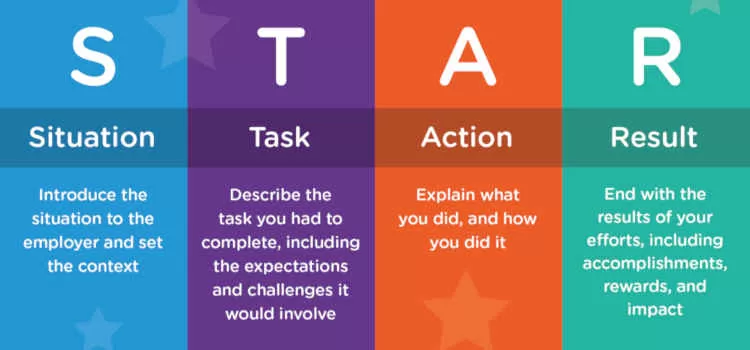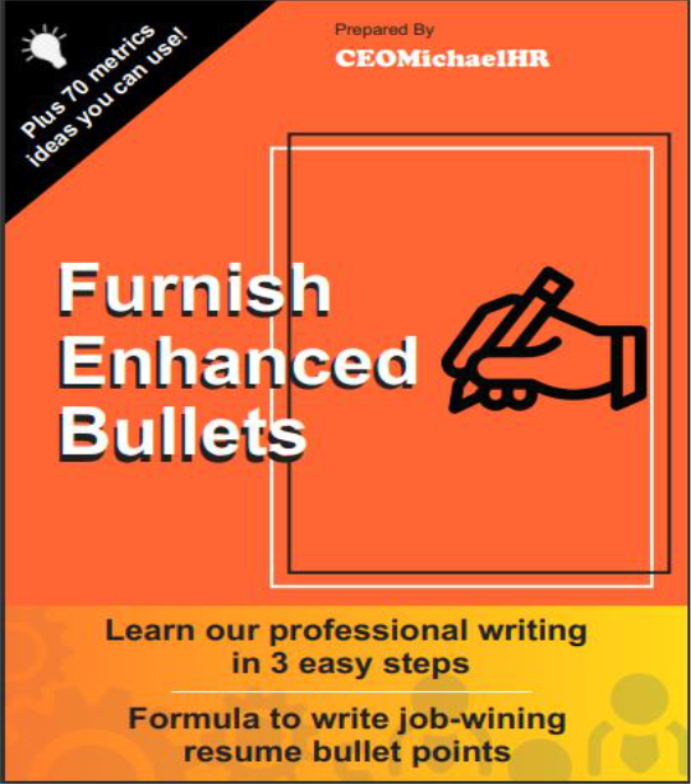
New clients, unlock 10% off all plans 🔥 at checkout with code: CEO10SPECIAL (Limited Time Offer)
New clients, unlock 10% off all plans 🔥 at checkout with code: CEO10SPECIAL (Limited Time Offer)






Behavioral job interview questions can be quite challenging. You rack your brain in search of a great response, but on the spot, your mind draws a blank.
So, you blurt out something awkward (an instant pang of regret) and cross your fingers, hoping the interviewer will overlook that slip-up.
…Hold on, it didn’t have to unfold this way. There’s a proven technique to deliver impressive answers to every behavioral job interview question:
The STAR Method.
Within this guide, we’re about to demystify what precisely this method entails and how to wield it to shine in your upcoming job interview!
Continue reading to discover:
Sounds enticing, doesn’t it?
Let’s embark on this journey!

Let’s start at the beginning – what precisely is the STAR method?
In essence, the STAR method is a well-organized approach designed to tackle a wide array of behavioral interview questions.
Here’s the breakdown:
(S) Situation – What’s the backdrop? Begin by elucidating the circumstances or context.
(T) Task – Elaborate on your duties or the specific tasks you needed to accomplish (i.e., what presented a challenge in this task?).
(A) Action – How did you address the situation? Delve into your methodology and the sequential steps you undertook.
(R) Results – Depict the outcomes of your actions. If feasible, incorporate quantifiable data or concrete figures (e.g., what percentage did you augment overall sales by? What tangible changes occurred?).
While the STAR method can be applied to ANY interview question, its true efficacy shines when responding to behavioral interview questions.
Now, what DO behavioral interview questions entail, exactly?
In a nutshell, they resemble standard interview queries, but their primary focus centers on real-life work scenarios.
Interview Question
What’s your most prominent strength?
as opposed to
Behavioral Interview Question
Share a compelling instance of when you harnessed your key strength in a professional context and elucidate the outcomes it yielded.
Sounds logical, doesn’t it?
Now, consider these exemplars of such queries:
Now that you grasp the essence of behavioral interview questions, let’s examine a sample response that adheres to the STAR method:
Practical Illustration
Behavioral Interview Question:
“Share with me an instance where you had to employ a highly strategic approach to fulfill all your obligations within a specific deadline.”
Exemplary Response:
Situation – “In general, I tend to meticulously plan my workweeks ahead of time. However, during my tenure as a sales manager at Company X, I faced a sudden challenge when we needed to transition our team to a new customer relationship management (CRM) software. The previous software unexpectedly altered its pricing model, rendering it financially impractical for us.”
Task – “My task was to identify a new software solution that met our requirements, all before the end of Q3 when the price increase would come into effect. Simultaneously, I needed to maintain my own sales performance and ensure that the new tool was user-friendly for our employees.”
Action – “To tackle this challenge, I adopted a meticulous time management strategy. First, I consulted our sales associates to pinpoint the primary issues with our existing CRM, beyond just the pricing aspect. Following that, I dedicated 1-2 hours each day to research potential solutions and, once identified, oversaw the data migration process. I took care to clean up old contacts, update missing information in our current leads, and provided training to the team on the new software. Throughout this period, I maintained my usual daily responsibilities, delivering consistent performance.”
Results – “Ultimately, we successfully completed the transition, albeit one week later than the initial deadline. I exceeded my sales goals for the quarter by 12%, and the team embraced the new CRM. This approach, characterized by foresight and efficient time allocation, yielded positive results.”
This response adheres closely to the STAR method, offering an appropriate amount of context, outlining the challenge without excessive detail, articulating the problem-solving process, and culminating with tangible data and statistics to underscore the accomplishments.
Employing this formula can significantly enhance the structure of your response, ensuring that the HR manager can easily follow your narrative.
Should you aspire to excel in your response, remember these key principles when applying the STAR structure to ace your interview:
Find out: 10 Signs an Interview Went Well or Bad
Understanding the acronym is merely the initial stride.
Here’s the definitive approach to extracting maximum value from this method:
Seems like a no-brainer, doesn’t it?
However, consider this:
Even if you meticulously adhere to the STAR framework, its efficacy diminishes if your response lacks relevance.
Ponder this: What’s the essence of your message?
Ideally, it should align with your role and spotlight your competencies relevant to the desired position.
For instance, if you aspire to a graphic design role, delving into your paramount achievement in accounting would be a puzzling detour, wouldn’t it?
In essence, if your answer doesn’t dovetail with the job requirements, it might as well be rendered inconsequential.
Anticipating the precise behavioral interview questions you’ll face is a futile endeavor. However, it’s a wise strategy to arm yourself with a handful of instances, each meticulously aligned with the esteemed STAR method.
This approach offers you the flexibility to fine-tune and tailor your response on the fly, catering to the specific question posed.
Nevertheless, bear in mind that your responses should never be regurgitated verbatim scripts. Authenticity is key in your delivery.
Should you find yourself grappling for a response amidst the interview’s intensity, don’t hesitate to request a brief pause to conjure up a suitable example.
Taking a moment to mentally structure your response demonstrates your commitment to providing well-thought-out answers, a quality that HR managers may well admire.
Key note:
***While the enigmatic nature of interview questions remains, you can proactively equip yourself for the frequently encountered interview questions. Explore our comprehensive list of 15 top situational interview questions and their insightful answers right here!
Consider narrating an anecdote wherein you rescued a client’s project from the brink of failure.
You swiftly assumed control and ensured everyone was clear on their tasks.
This is precisely what the interviewer is eager to hear about.
Nonetheless, there’s no need to:
As emphasized earlier, your response should remain pertinent and laser-focused.
Hence, while recounting the scenario, aim to encapsulate the lead-up to your narrative within a concise 1-2 sentences.
Now, it’s your moment to shine.
Fear not, for it’s time to unveil the intricate workings of your achievements. Ensure to articulate the following:
No recruiter shall be content with a humdrum conclusion like, “Well, we wrapped up the project on schedule, and everyone went on their merry way.”
Witness the dullness in that proclamation?
Even if your tale’s conclusion lacks grandeur, seize the opportunity to divulge the wisdom acquired.
Find out: How to Respond to Desired Salary Questions on Job Applications and in Interviews

Your response following the STAR method depends on the specific behavioral interview question asked.
To empower your preparation, we’re equipping you with 9 additional common behavioral interview questions, each accompanied by illustrative responses:
1. Share your proudest achievement.
2. Describe your approach to achieving personal goals while under pressure.
3. Narrate an instance when you encountered conflict or disagreement with a colleague. What transpired, and how did you navigate it?
4. Explain your strategy for handling unforeseen challenges with a concrete example.
5. Recall a situation where a client’s error needed correction. Share the story.
6. Reflect on a moment of failure. What were the circumstances, and what insights did you gain?
7. Detail your approach to managing irate customers, supported by an example.
8. Recount an episode when you went above and beyond to enhance the customer experience.
9. Narrate a goal you set but couldn’t achieve. What was your approach to this setback?
Let’s dive right in and unravel your interview success!
S – “During my tenure as a manager at Org. Z, we consistently experienced a surge in customers throughout the bustling summer months, often leaving us short-staffed and overwhelmed.”
T – “In response, I devised a comprehensive strategy to ensure our team remained resilient and efficient during these demanding periods.”
A – “Recognizing the need for better preparation, I meticulously crafted a well-structured shift schedule for the upcoming summer and implemented a unique reward system for unforeseen staff shortages. In the event of illness or other unexpected absences, those who stepped up to fill the gap were generously compensated.”
R – “As a result, the summer season unfolded with remarkable ease, marked by a remarkable absence of negative TripAdvisor reviews. Unlike the prior year, when we received numerous complaints about slow service, this time, we garnered nothing but praise and satisfaction from our valued patrons.”
S – “Of course! To offer some context, during my tenure in university, I confronted the formidable challenge of limited financial assistance, coupled with the absence of parental support to bridge the tuition gap. Concurrently, I enthusiastically embraced an array of extracurricular engagements and eagerly pursued internships to amass invaluable professional exposure in anticipation of graduation.”
T – “In my quest to navigate this intricate balancing act, I swiftly recognized the pivotal importance of astute time management. Thus, I harnessed the capabilities of Google Calendar and procured a personal notepad to meticulously chronicle my daily responsibilities and undertakings.”
A – “With an unwavering resolve and tireless dedication, I adeptly harmonized my academic pursuits, a part-time job, and a myriad of extracurricular involvements. Undoubtedly, there were moments of weariness, yet I persevered. At the close of each day, I diligently reviewed and meticulously refined my calendar for the upcoming week. This methodical approach provided me with a comprehensive overview of my daily commitments, assuring that I never faltered on assignments or missed a solitary deadline.”
R – “In the end, my unyielding commitment bore fruits of success. I proudly graduated with a remarkable 3.7 GPA, unburdened by student loans, and clutched a portfolio teeming with creative prowess. This portfolio served as my golden ticket, swiftly ushering me into the professional realm, where I secured my inaugural role at the illustrious Company X a mere month after donning the graduation regalia.”
S – “Certainly! During my internship at Company X, my team confronted a challenge while tasked with devising innovative talent sourcing strategies for a rural supermarket chain client in need of fresh talent.”
T – “Our assignment involved daily meetings to brainstorm and finalize three standout ideas. Initially, our brainstorming sessions yielded some concepts, but none were exceptionally promising. The client sought a solution that would undoubtedly yield results.”
“Some team members advocated for presenting what we had and calling it quits. On the contrary, a fellow teammate and I were determined to refine our approach and develop an effective solution. This caused significant friction within the team, with constant rejection of our proposals, and the looming deadline added to the pressure.”
A – “To break this deadlock, I proposed a solution. Recognizing that our opposing viewpoints were hindering progress, we decided to introduce an impartial third party with no emotional investment in the matter.”
“We held an extended meeting without time constraints, systematically evaluating each idea. The third party acted as a mediator, ensuring that any proposal had to be substantiated with as many facts as possible to be considered.”
R – “This approach breathed new life into the discussions. The mediator helped sift through less promising ideas and injected fresh energy into the team. Ultimately, we successfully generated entirely original ideas that everyone agreed on.”
“Our two-hour meeting concluded with three outstanding ideas that our management confidently presented to the client. One of these ideas was implemented, resulting in the hiring of three new employees.”
Find out: Bad Interviews: Can Great Candidates Give Them?- All You Need to Know
S – “Once, in the midst of preparations for a high-stakes presentation at a prominent Company X conference, a curveball was thrown our way when one of our slated guest speakers had to pull out due to an unforeseen emergency. We were hit with this news merely hours before the event, and it left us with an unsettling 60-minute gap in our meticulously planned schedule.”
T – “With the clock ticking against us, our options were limited, and we needed to swiftly devise a solution to plug the sudden void.”
A – “Taking the reins as one of the principal event organizers and community managers within the company, I decided to step up and take charge. Rather than despairing over the lost speaker, I saw an opportunity. Our CEO, who had been intricately involved behind the scenes, was a viable alternative. I embarked on a whirlwind hour-long coaching session with him, helping him distill a decade’s worth of expertise into a compelling presentation. With just half an hour to spare, we were primed and ready to roll.”
R – “Out of that initial 60-minute gap, our impromptu presentation ran for approximately 45 minutes, with the remaining 15 minutes dedicated to engaging with questions from the audience. The event continued without a hitch, and the majority of our attendees lauded the CEO’s presentation.”
S – “Indeed, this circumstance arises from time to time.
One particular instance comes to mind from my early days as a recruiter. I had forwarded a candidate to a client, and the hiring manager promptly dismissed the candidate solely based on their resume. They asserted that the candidate lacked the necessary experience in areas X, Y, and Z.”
T – “I meticulously reviewed the candidate’s CV and my own notes, and I was absolutely confident that the client had made an error in their evaluation. The candidate was an exact match for the job description they had given me.
Consequently, I had to navigate the situation delicately without coming across as if I were instructing them on their own role.”
A – “I reached out to the candidate to gather comprehensive information about their experience in X, Y, and Z. I compiled this information into a well-structured email and, maintaining a professional and composed tone, clarified to the client’s hiring manager that our candidate did, indeed, possess the necessary experience, supported by specific project examples. I politely requested a reconsideration of the candidate’s application.”
R – “The hiring manager acknowledged their error, conceded that the candidate did meet the required criteria, and admitted to their oversight. Consequently, they extended an interview invitation to the candidate. Although the candidate ultimately wasn’t selected for the position, at least we provided them with an opportunity.”
S – “In a previous role, I led a team responsible for developing an online e-commerce platform for one of our clients. Looking back, I can see that I was overly optimistic about the project’s timeline. I confidently assured them that we could complete it within two months, believing it to be a straightforward endeavor. However, about two weeks into the project, it became apparent that we had miscalculated. We discovered that many elements required custom coding, contrary to our initial assumptions.”
T – “Consequently, I had to convey this setback to the client, provide them with a revised timeline, and take responsibility for my error.”
A – “Upon discussing the issue with the client, they were understanding but understandably displeased. In response, I immediately convened our team of web developers and launched into a focused effort to resolve the problem. We dedicated our full attention to rectifying the situation, outsourced some minor tasks to expedite progress, and ultimately managed to address all issues before the updated deadline.”
R – “In the end, the client’s e-commerce website was a resounding success. This experience imparted a vital lesson in managing expectations. I came to realize that it’s often wiser to underpromise and overdeliver, and I honed my skills in setting and overseeing realistic deadlines for my team.”
Find out: Is It an Interview or Not? Interview Tips for Either Way
S – “My approach in handling difficult customer interactions is to maintain composure and professionalism. Recently, I encountered a situation where a customer became visibly upset at the checkout counter, insisting on a refund despite our policy.”
T – “I recognized the need to address this issue promptly, as the commotion was drawing attention from other customers in line.”
A – “To diffuse the tension, I made the decision to relocate the conversation to a quieter area. I asked a colleague to assist at the register while I engaged with the upset customer privately. During our one-on-one conversation, I acknowledged his frustration and empathized with his situation. I then clarified our policy, explaining that sale items were non-refundable, even with a receipt.”
R – “Ultimately, he began to calm down and accepted my explanation, albeit still dissatisfied. By remaining composed and understanding throughout the exchange, I was able to de-escalate the situation before it escalated further. I firmly believe that maintaining a calm and empathetic approach can resolve most, if not all, challenging customer interactions.
S – “During my tenure at Company X, we were in the midst of preparing a video presentation for a client, and I discovered that a member of their team had a hearing impairment. The presentation was scheduled for the following morning, and it was past 5 PM with only me left in the office.”
T – “Recognizing the importance of inclusivity, I realized that the best course of action was for me to extend my workday into the evening to personally add captions to the video.”
A – “It was a time-consuming task, and by approximately 8 PM, I had completed the captioning. I promptly informed our team of the update.”
R – “Ultimately, the client was not only pleased with the presentation but also genuinely impressed (and pleasantly surprised) by our meticulous attention to detail. As a result, we secured their business shortly thereafter.”
Find out: How to Write a Targeted Resume That Lands You an Interview
S – “During my tenure at my previous position, we embarked on a strategic initiative to bolster our blog’s prominence as a marketing tool. The responsibility fell on my shoulders to helm the blog and generate content, even though I lacked prior experience in this domain.”
T – “My task was to craft a total of five articles within the span of one month, devise corresponding social media content, and actively promote them.”
A – “Around the halfway mark, I confronted the harsh reality that my writing skills were subpar, and I had nothing substantial to showcase for the month’s endeavor. Recognizing this, I promptly engaged in a candid conversation with the Chief Marketing Officer, outlining my predicament. Together, we formulated an innovative solution – to recruit talented content writers through UpWork, with me overseeing them in a role akin to a content strategist.”
R – “Ultimately, we successfully onboarded a proficient content writer who managed to deliver four articles well before the deadline. I closely collaborated with them to ensure that their work aligned with our brand’s identity, additionally overseeing the creation of social media posts and promoting the content. The articles not only met our expectations but also yielded tangible results, attracting a noteworthy influx of new leads.”
Indeed, interviews can evoke a sense of fear.
Yet, armed with the STAR method, your prospects of triumphing in them substantially increase!
Now, let’s review the wealth of knowledge we’ve gathered:
The format is refreshingly uncomplicated. Be diligent in ensuring your responses maintain relevance, offer comprehensive context, articulate your decision-making process, and culminate with concrete data and statistics.
If you seek illustrative responses, draw inspiration from the examples provided above.
Are you in pursuit of further strategies for interview preparation and the pursuit of interview success?
Look no further than the CEOMichaelHR career blog, your premier source for cutting-edge career advice and actionable roadmaps!
Share
Further Reading
*The names and logos of the companies referred to in this page are all trademarks of their respective holders. Unless specifically stated otherwise, such references are not intended to imply any affiliation or association with CEOMichaelHR.
Land interviews 3x faster while submitting fewer resumes
Copyright © 2025, ceomichaelhr.com.
All rights reserved.
Land interviews 3x faster while submitting fewer resumes
Copyright © 2025, ceomichaelhr.com.
All rights reserved.

Learn the same techniques our expert resume writers have used to get thousands of clients closer to their next job
Unlock expert resume tips, start landing multiple interviews!

Stay connected to receive powerful career insights, updates, and inspiration that’ll help you hit your 2023 career goals.